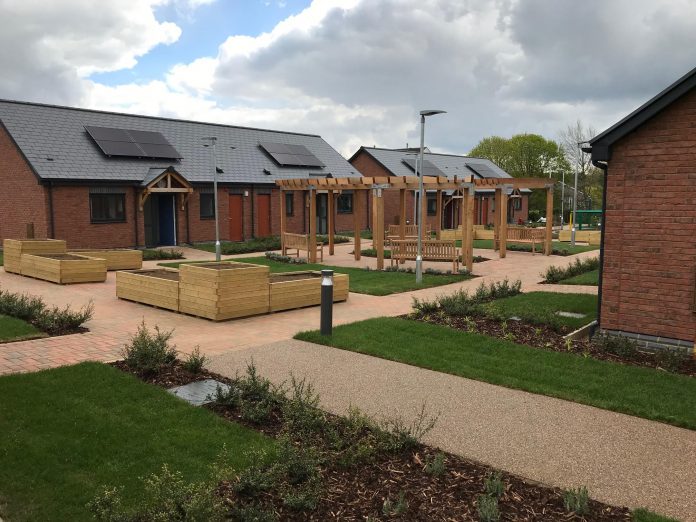Gavin Bashar, UK managing director at Tunstall Healthcare, discusses why technology should be integrated into buildings from the design and construction stage
The use of smart technology has surged in the past decade, with the global market doubling in value from $43.4bn in 2017 to an expected $91bn in 2022. From its use in the home to integration in most sectors of the economy from banking to shopping, it’s been adopted to enhance the experience of consumers. The pandemic further amplified the benefits and adoption of smart technology, and also saw a spotlight placed on its role in connecting people and helping care services to support the health and wellbeing of our population.
As we begin to emerge from the pandemic, the time is right for local governments, architects and builders to understand the best ways to deploy technology to support health and care needs in a range of environments and the benefits of considering its inclusion as part of construction design.
Whether it’s a state-of-the-art residential care home, a new development of assisted living facilities, or premium retirement development, a holistic approach to care that integrates technology is required. This is reliant upon architects, engineers and construction teams working closely with health, housing and care providers to ensure systems are embedded into the fabric of buildings to meet the needs and expectations of a 21st century, technologically-enabled population.
Creating a digitally enabled future
Technology has a key role to play in services being delivered in innovative ways, placing citizens at the heart of decision making. This enables us to lead population health management and service provision by example.
Using technology to support people is low cost, and helps citizens to live independently for longer with an increased quality of life. Relatively low-cost telecare systems can help to avoid hospital admission, delay and prevent the need for residential care, and reduce carer burnout. Architects and builders, therefore, have a crucial role to play in driving cost savings and enhancing the lives of vulnerable service users.
As technology advances, we have the capability to not just react to events but to predict and even prevent them. For example, sensors in the home can detect the usage of the bathroom or kitchen appliances. This in turn can indicate a possible deterioration in self-care, nutrition or health, and enable early intervention. In group living environments the same technology can enable care to be delivered where and when it is needed most.
Understanding solutions that are required and adapting as things change – not to be driven by contracts but in providing solutions – will ensure innovation continues to flourish. We need to go back to a stage before solution building so that if we understand the problems faced on a daily basis, we are better placed to co-design straightforward and effective solutions.
As the UK’s communications network is set to complete its transition from analogue to digital by 2025, technology has an even greater role to play in enhancing the lives of service users. Although this will require significant engagement from architects and builders, it brings a once in a generation opportunity to modernise, improve and shift thinking from a reactive to a proactive delivery model which can empower users and enable care to become more intelligent and personalised.
What are the benefits of digital innovation?
Technology has historically been seen as an addition to existing service delivery, rather than a means of transforming models of care, leading to difficulties in integrating technology effectively at an early stage.
We must lead from the top to ensure buildings have technology integrated at construction to enable stakeholders to support citizens effectively and provide a platform to make the most of future advances in technology. Too often, technology is considered as an afterthought, rather than a system that can be central to the way the building is lived, used and worked in, and therefore this is pivotal to the way it is designed.
Existing solutions already have an array of benefits that continue to be demonstrated. For example, Remote Patient Monitoring (RPM) enables ongoing support and early intervention, helping to reduce the need for more complex care for people living with chronic conditions.
TECS or telecare systems can be tailored to the needs of every user and can easily connect to specialist monitoring centres or onsite care staff at the touch of a button, 24 hours a day, helping to automatically monitor and manage risks. In addition, devices such as smoke, gas, flood and fall detectors can automatically raise the alarm to ensure a response if the individual is unable or unwilling to communicate this themselves.
Rapid response to events can mitigate their effects; for example, the fire service attending sooner than may otherwise be the case, or avoiding a “long lie” after a fall. It also provides 24-hour reassurance to the user and family members that emergencies will be responded to. Such technology is scalable, cost-effective and helps individuals to remain independent for longer, as well as care to be person-centred rather than place-based.
Digital innovation and integration can improve citizen experience, support better quality and greater reliability of service provision, and provide enhanced services which are tailored to meet specific needs.
These new approaches can benefit end-users as we continue to see innovation within the health tech sector and the impact this is having on building design and construction. A reduction in the need to travel to appointments with clinicians or carers, real-time data provision, and a reduction in hospitalisation will all improve the outcomes for users, reduce costs, and change the way that health and social care buildings are designed and developed. These benefits are only a hint of how health, housing and social care can be streamlined and strengthened if innovation and technology are placed at the heart of our services.
Case study: Northampton Partnership Homes (NPH) and Jeakins Weir
Northampton Partnership Homes (NPH) and construction firm, Jeakins Weir recently worked together to integrate smart technology into a new innovative housing development comprising eight semi-detached bungalows that will support the independence of young adults with learning disabilities and complex needs.
Smart technology was integrated at the planning stage of the development to provide more person-centred support, as well as offer greater insight into how best to allocate resources to meet the needs of the people living there.
The system supports the use of telecare sensors and wearable technology, such as fall detectors, which will automatically raise an alert if help is required, enabling care to be given where and when it is needed, but supporting independence when it isn’t.
21st century healthcare system must have digital innovation at its core
A healthcare system fit for the 21st century must have digital innovation at its core which is embraced by architects and builders. As innovative technology continues to transform every aspect of modern life, there is a growing body of evidence demonstrating the impact this is having on population health and wellbeing. Where it has not already done so, digitisation is set to touch every corner of health and social care, and in turn, this needs to impact the way we design and build.
We’re also beginning to see the next generation of predictive care technology, and over the next few years, architects and builders should expect to see such systems become embedded into the fabric of buildings to enable more anticipatory care delivery.
With an extra six million over 65s expected between now and 2040, our ageing population means we have no choice but to look at the ways we can deliver care differently in order to manage demand, and our homes must be considered a focal point in the health and social care landscape of the future.

















